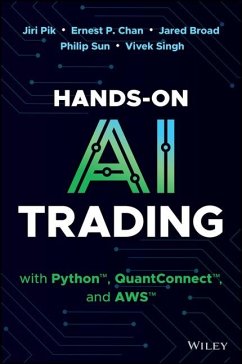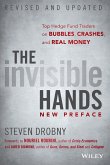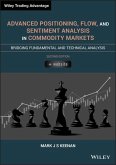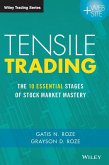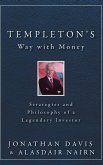Jiri Pik, Ernest P Chan, Jared Broad, Philip Sun, Vivek Singh
Hands-On AI Trading with Python, Quantconnect, and AWS
Jiri Pik, Ernest P Chan, Jared Broad, Philip Sun, Vivek Singh
Hands-On AI Trading with Python, Quantconnect, and AWS
- Gebundenes Buch
- Merkliste
- Auf die Merkliste
- Bewerten Bewerten
- Teilen
- Produkt teilen
- Produkterinnerung
- Produkterinnerung
"Book Summary: This book is tailored for students, traders, and quants in finance who want to understand modern trading strategies and enhance them with artificial intelligence. It assumes basic knowledge of Python 3.x and familiarity with finance and trading concepts. Goals: AI Overview: Introduces key AI algorithms and best practices in financial trading. Intuitive Learning: Uses real-world examples to explain how algorithms work. Easy Experimentation: Provides a straightforward setup using QuantConnect.com for testing algorithms without complex infrastructure. The book avoids detailed…mehr
Andere Kunden interessierten sich auch für
![The Invisible Hands The Invisible Hands]() Steven DrobnyThe Invisible Hands23,99 €
Steven DrobnyThe Invisible Hands23,99 €![The Hands that Feed Us The Hands that Feed Us]() Gordon MacNeilThe Hands that Feed Us27,99 €
Gordon MacNeilThe Hands that Feed Us27,99 €![Advanced Positioning, Flow, and Sentiment Analysis in Commodity Markets Advanced Positioning, Flow, and Sentiment Analysis in Commodity Markets]() Mark J S KeenanAdvanced Positioning, Flow, and Sentiment Analysis in Commodity Markets123,99 €
Mark J S KeenanAdvanced Positioning, Flow, and Sentiment Analysis in Commodity Markets123,99 €![Tensile Trading Tensile Trading]() Gatis N. RozeTensile Trading68,99 €
Gatis N. RozeTensile Trading68,99 €![Templeton's Way with Money Templeton's Way with Money]() Alasdair NairnTempleton's Way with Money38,99 €
Alasdair NairnTempleton's Way with Money38,99 €![The Invisible Hands of U.S. Commercial Banking Reform The Invisible Hands of U.S. Commercial Banking Reform]() Margaret M. PolskiThe Invisible Hands of U.S. Commercial Banking Reform81,99 €
Margaret M. PolskiThe Invisible Hands of U.S. Commercial Banking Reform81,99 €![The Advanced Swing Trading Guide The Advanced Swing Trading Guide]() Neil SharpThe Advanced Swing Trading Guide19,99 €
Neil SharpThe Advanced Swing Trading Guide19,99 €-
"Book Summary: This book is tailored for students, traders, and quants in finance who want to understand modern trading strategies and enhance them with artificial intelligence. It assumes basic knowledge of Python 3.x and familiarity with finance and trading concepts. Goals: AI Overview: Introduces key AI algorithms and best practices in financial trading. Intuitive Learning: Uses real-world examples to explain how algorithms work. Easy Experimentation: Provides a straightforward setup using QuantConnect.com for testing algorithms without complex infrastructure. The book avoids detailed infrastructure setup and large model training, instead using pre-trained models from AWS Bedrock, MLFinLab, or PredictNow.ai, making it accessible for readers to apply AI in trading strategies effectively"--
Hinweis: Dieser Artikel kann nur an eine deutsche Lieferadresse ausgeliefert werden.
Hinweis: Dieser Artikel kann nur an eine deutsche Lieferadresse ausgeliefert werden.
Produktdetails
- Produktdetails
- Verlag: Wiley
- Seitenzahl: 416
- Erscheinungstermin: 29. Januar 2025
- Englisch
- Abmessung: 254mm x 180mm x 23mm
- Gewicht: 998g
- ISBN-13: 9781394268436
- ISBN-10: 1394268432
- Artikelnr.: 70990006
- Herstellerkennzeichnung
- Libri GmbH
- Europaallee 1
- 36244 Bad Hersfeld
- gpsr@libri.de
- Verlag: Wiley
- Seitenzahl: 416
- Erscheinungstermin: 29. Januar 2025
- Englisch
- Abmessung: 254mm x 180mm x 23mm
- Gewicht: 998g
- ISBN-13: 9781394268436
- ISBN-10: 1394268432
- Artikelnr.: 70990006
- Herstellerkennzeichnung
- Libri GmbH
- Europaallee 1
- 36244 Bad Hersfeld
- gpsr@libri.de
Biographies xiii
Preface: QuantConnect xv
Introduction xxiii
Part I Foundations of Capital Markets and Quantitative Trading 1
Chapter 1 Foundations of Capital Markets 3
Market Mechanics 3
Market Participants 4
Trading Is the "Play" 4
The Stage and Basic Rules of Trading-The Limit Order Book 4
Actors-Liquidity Trader, Market Maker, and
Informed Trader 5
Liquidity Trader 5
Market Maker 5
Informed Trader 6
AI Actors Wanted! 7
Data and Data Feeds 7
Custom and Alternative Data 9
Brokerages and Transaction Costs 10
Transaction Costs 11
Security Identifiers 13
Assets and Derivatives 15
US Equities 15
US Equity Options 19
Index Options 21
US Futures 21
Cryptocurrency 23
Chapter 2 Foundations of Quantitative Trading 25
Research Process 25
Research 25
Backtesting 26
Parameter Optimization 26
Paper and Live Trading 26
Testing and Debugging Tools 26
Debuggers 27
Logging 27
Charting 27
Object Store 28
Coding Process 28
Time and Look-ahead Bias 29
Look-ahead Bias 29
Market Hours and Scheduling 30
Strategy Styles 30
Trading Signals 31
Allocating Capital 31
Regimes and Portfolios of Strategies 32
Parameter Sensitivity Testing and Optimization 33
1. Remove 33
2. Replace 34
3. Reduce 34
Parameter Sensitivity Testing 34
Margin Modeling 35
Equities 35
Equity Options 36
Futures 37
Diversification and Asset Selection 37
Fundamental Asset Selection 38
ETF Constituents Asset Selection 39
Dollar-Volume Asset Selection 40
Universe Settings 40
Indicators and Other Data Transformations 41
Automatic Indicators 41
Manual Indicators 41
Indicator Warm Up 42
Storing Objects 42
Indicator Events 42
Sourcing Ideas 42
Hypothesis-driven Testing 43
Data Driven Investing 44
Quantpedia 44
QuantConnect Research and Strategy Explorer 45
Part II Foundations of AI and ML in Algorithmic Trading 47
Step-by-step Guide for AI-based Algorithmic Trading 48
Chapter 3 Step 1: Problem Definition 49
Chapter 4 Step 2: Dataset Preparation 53
Data Collection 53
Exploratory Data Analysis 53
Data Preprocessing 54
Handling Missing Data 55
Handling Outliers 58
Feature Engineering 61
Normalization and Standardization of Features 62
Transforming Time Series Features to Stationary 64
Identification of Cointegrated Time Series with Engle-Granger Test 70
Feature Selection 76
Correlation Analysis 76
Feature Importance Analysis 77
Auto-identification of Features 78
Dimensionality Reduction/Principal Component Analysis 80
Splitting of Dataset into Training, Testing, and Possibly Validation Sets
83
How to Split Your Data 83
Chapter 5 Step 3: Model Choice, Training, and Application 87
Regression 88
Linear Regression 89
Polynomial Regression 91
LASSO Regression 93
Ridge Regression 96
Markov Switching Dynamic Regression 99
Decision Tree Regression 103
Support Vector Machines Regression with
Wavelet Forecasting 105
Classification 110
Multiclass Random Forest Model 110
Logistic Regression 114
Hidden Markov Models 117
Gaussian Naive Bayes 119
Convolutional Neural Networks 122
Ranking 127
LGBRanker Ranking 127
Clustering 130
OPTICS Clustering 130
Language Models 132
OpenAI Language Model 132
Amazon Chronos Model 135
FinBERT Model 137
Part III Advanced Applications of AI in Trading and Risk Management 141
Getting Started with Source Code 141
Chapter 6 Applied Machine Learning 143
Example 1-ML Trend Scanning with MLFinlab 143
Example 2-Factor Preprocessing Techniques for Regime Detection 148
Example 3-Reversion vs. Trending: Strategy Selection by Classification 154
Example 4-Alpha by Hidden Markov Models 158
Example 5-FX SVM Wavelet Forecasting 170
Example 6-Dividend Harvesting Selection of
High-Yield Assets 176
Example 7-Effect of Positive-Negative Splits 181
Example 8-Stop Loss Based on Historical Volatility and Drawdown Recovery
185
Example 9-ML Trading Pairs Selection 197
Example 10-Stock Selection through Clustering
Fundamental Data 207
Example 11-Inverse Volatility Rank and Allocate to Future Contracts 214
Example 12-Trading Costs Optimization 221
Example 13-PCA Statistical Arbitrage Mean Reversion 228
Example 14-Temporal CNN Prediction 233
Example 15-Gaussian Classifier for Direction Prediction 242
Example 16-LLM Summarization of Tiingo News Articles 250
Example 17-Head Shoulders Pattern Matching with CNN 256
Example 18-Amazon Chronos Model 265
Example 19-FinBERT Model 272
Chapter 7 Better Hedging with Reinforcement Learning 281
Introduction 281
A New AI Trading Assistant 281
Continuous Hedging Is Not Required 282
Machine Learning Comes to the Rescue 283
A Simplified but Effective Reinforcement
Learning Approach 284
Overview of the Reinforcement Learning 285
Identification 285
Simulation 286
Ref inement Training on Actual Market Data 287
Testing and Implementation 287
Implementation on QuantConnect 288
Primary Research Notebook 289
The Policy Network 290
Model Functions 292
Fine-tuning with Market Data 296
Results 300
Conclusion 303
Chapter 8 AI for Risk Management and Optimization 305
What Is Corrective AI and Conditional
Parameter Optimization? 305
Feature Engineering 308
Applying Corrective AI to Daily Seasonal Forex Trading 312
What Is Conditional Parameter Optimization? 318
Applying Conditional Parameter Optimization to an ETF Strategy 319
Unconditional vs. Conditional Parameter Optimizations 320
Performance Comparisons 322
Conditional Portfolio Optimization 322
Regime Changes Obliterate Traditional Portfolio Optimization Methods 322
Learning to Optimize 324
Ranking Is Easier Than Predicting 325
The Fama-French Lineage 327
Comparison with Conventional Optimization Methods 327
Model Tactical Asset Allocation Portfolio 331
CPO Software-as-a-Service 333
Conclusion 340
Definitions of Spread_EMA & Spread_VAR 340
Chapter 9 Application of Large Language Models and Generative AI in Trading
341
Role of Generative AI in Creating Alpha 341
Selecting an LLM for Building a Generative AI Application 342
Prompt Engineering 344
Prompt Engineering in Practice 345
Addressing Model "Hallucination" 346
Question Answering Using a Retrieval Augmented Application in SageMaker
Canvas 347
RAG Application Costs and Optimization Techniques 350
Testing Our Infrastructure 351
Summarization 356
Useful AI Platforms and Services 359
ChatGPT 359
Gemini 359
Bedrock 359
SageMaker 359
Q Business 360
References 361
Subject Index 363
Code Index 379
Preface: QuantConnect xv
Introduction xxiii
Part I Foundations of Capital Markets and Quantitative Trading 1
Chapter 1 Foundations of Capital Markets 3
Market Mechanics 3
Market Participants 4
Trading Is the "Play" 4
The Stage and Basic Rules of Trading-The Limit Order Book 4
Actors-Liquidity Trader, Market Maker, and
Informed Trader 5
Liquidity Trader 5
Market Maker 5
Informed Trader 6
AI Actors Wanted! 7
Data and Data Feeds 7
Custom and Alternative Data 9
Brokerages and Transaction Costs 10
Transaction Costs 11
Security Identifiers 13
Assets and Derivatives 15
US Equities 15
US Equity Options 19
Index Options 21
US Futures 21
Cryptocurrency 23
Chapter 2 Foundations of Quantitative Trading 25
Research Process 25
Research 25
Backtesting 26
Parameter Optimization 26
Paper and Live Trading 26
Testing and Debugging Tools 26
Debuggers 27
Logging 27
Charting 27
Object Store 28
Coding Process 28
Time and Look-ahead Bias 29
Look-ahead Bias 29
Market Hours and Scheduling 30
Strategy Styles 30
Trading Signals 31
Allocating Capital 31
Regimes and Portfolios of Strategies 32
Parameter Sensitivity Testing and Optimization 33
1. Remove 33
2. Replace 34
3. Reduce 34
Parameter Sensitivity Testing 34
Margin Modeling 35
Equities 35
Equity Options 36
Futures 37
Diversification and Asset Selection 37
Fundamental Asset Selection 38
ETF Constituents Asset Selection 39
Dollar-Volume Asset Selection 40
Universe Settings 40
Indicators and Other Data Transformations 41
Automatic Indicators 41
Manual Indicators 41
Indicator Warm Up 42
Storing Objects 42
Indicator Events 42
Sourcing Ideas 42
Hypothesis-driven Testing 43
Data Driven Investing 44
Quantpedia 44
QuantConnect Research and Strategy Explorer 45
Part II Foundations of AI and ML in Algorithmic Trading 47
Step-by-step Guide for AI-based Algorithmic Trading 48
Chapter 3 Step 1: Problem Definition 49
Chapter 4 Step 2: Dataset Preparation 53
Data Collection 53
Exploratory Data Analysis 53
Data Preprocessing 54
Handling Missing Data 55
Handling Outliers 58
Feature Engineering 61
Normalization and Standardization of Features 62
Transforming Time Series Features to Stationary 64
Identification of Cointegrated Time Series with Engle-Granger Test 70
Feature Selection 76
Correlation Analysis 76
Feature Importance Analysis 77
Auto-identification of Features 78
Dimensionality Reduction/Principal Component Analysis 80
Splitting of Dataset into Training, Testing, and Possibly Validation Sets
83
How to Split Your Data 83
Chapter 5 Step 3: Model Choice, Training, and Application 87
Regression 88
Linear Regression 89
Polynomial Regression 91
LASSO Regression 93
Ridge Regression 96
Markov Switching Dynamic Regression 99
Decision Tree Regression 103
Support Vector Machines Regression with
Wavelet Forecasting 105
Classification 110
Multiclass Random Forest Model 110
Logistic Regression 114
Hidden Markov Models 117
Gaussian Naive Bayes 119
Convolutional Neural Networks 122
Ranking 127
LGBRanker Ranking 127
Clustering 130
OPTICS Clustering 130
Language Models 132
OpenAI Language Model 132
Amazon Chronos Model 135
FinBERT Model 137
Part III Advanced Applications of AI in Trading and Risk Management 141
Getting Started with Source Code 141
Chapter 6 Applied Machine Learning 143
Example 1-ML Trend Scanning with MLFinlab 143
Example 2-Factor Preprocessing Techniques for Regime Detection 148
Example 3-Reversion vs. Trending: Strategy Selection by Classification 154
Example 4-Alpha by Hidden Markov Models 158
Example 5-FX SVM Wavelet Forecasting 170
Example 6-Dividend Harvesting Selection of
High-Yield Assets 176
Example 7-Effect of Positive-Negative Splits 181
Example 8-Stop Loss Based on Historical Volatility and Drawdown Recovery
185
Example 9-ML Trading Pairs Selection 197
Example 10-Stock Selection through Clustering
Fundamental Data 207
Example 11-Inverse Volatility Rank and Allocate to Future Contracts 214
Example 12-Trading Costs Optimization 221
Example 13-PCA Statistical Arbitrage Mean Reversion 228
Example 14-Temporal CNN Prediction 233
Example 15-Gaussian Classifier for Direction Prediction 242
Example 16-LLM Summarization of Tiingo News Articles 250
Example 17-Head Shoulders Pattern Matching with CNN 256
Example 18-Amazon Chronos Model 265
Example 19-FinBERT Model 272
Chapter 7 Better Hedging with Reinforcement Learning 281
Introduction 281
A New AI Trading Assistant 281
Continuous Hedging Is Not Required 282
Machine Learning Comes to the Rescue 283
A Simplified but Effective Reinforcement
Learning Approach 284
Overview of the Reinforcement Learning 285
Identification 285
Simulation 286
Ref inement Training on Actual Market Data 287
Testing and Implementation 287
Implementation on QuantConnect 288
Primary Research Notebook 289
The Policy Network 290
Model Functions 292
Fine-tuning with Market Data 296
Results 300
Conclusion 303
Chapter 8 AI for Risk Management and Optimization 305
What Is Corrective AI and Conditional
Parameter Optimization? 305
Feature Engineering 308
Applying Corrective AI to Daily Seasonal Forex Trading 312
What Is Conditional Parameter Optimization? 318
Applying Conditional Parameter Optimization to an ETF Strategy 319
Unconditional vs. Conditional Parameter Optimizations 320
Performance Comparisons 322
Conditional Portfolio Optimization 322
Regime Changes Obliterate Traditional Portfolio Optimization Methods 322
Learning to Optimize 324
Ranking Is Easier Than Predicting 325
The Fama-French Lineage 327
Comparison with Conventional Optimization Methods 327
Model Tactical Asset Allocation Portfolio 331
CPO Software-as-a-Service 333
Conclusion 340
Definitions of Spread_EMA & Spread_VAR 340
Chapter 9 Application of Large Language Models and Generative AI in Trading
341
Role of Generative AI in Creating Alpha 341
Selecting an LLM for Building a Generative AI Application 342
Prompt Engineering 344
Prompt Engineering in Practice 345
Addressing Model "Hallucination" 346
Question Answering Using a Retrieval Augmented Application in SageMaker
Canvas 347
RAG Application Costs and Optimization Techniques 350
Testing Our Infrastructure 351
Summarization 356
Useful AI Platforms and Services 359
ChatGPT 359
Gemini 359
Bedrock 359
SageMaker 359
Q Business 360
References 361
Subject Index 363
Code Index 379
Biographies xiii
Preface: QuantConnect xv
Introduction xxiii
Part I Foundations of Capital Markets and Quantitative Trading 1
Chapter 1 Foundations of Capital Markets 3
Market Mechanics 3
Market Participants 4
Trading Is the "Play" 4
The Stage and Basic Rules of Trading-The Limit Order Book 4
Actors-Liquidity Trader, Market Maker, and
Informed Trader 5
Liquidity Trader 5
Market Maker 5
Informed Trader 6
AI Actors Wanted! 7
Data and Data Feeds 7
Custom and Alternative Data 9
Brokerages and Transaction Costs 10
Transaction Costs 11
Security Identifiers 13
Assets and Derivatives 15
US Equities 15
US Equity Options 19
Index Options 21
US Futures 21
Cryptocurrency 23
Chapter 2 Foundations of Quantitative Trading 25
Research Process 25
Research 25
Backtesting 26
Parameter Optimization 26
Paper and Live Trading 26
Testing and Debugging Tools 26
Debuggers 27
Logging 27
Charting 27
Object Store 28
Coding Process 28
Time and Look-ahead Bias 29
Look-ahead Bias 29
Market Hours and Scheduling 30
Strategy Styles 30
Trading Signals 31
Allocating Capital 31
Regimes and Portfolios of Strategies 32
Parameter Sensitivity Testing and Optimization 33
1. Remove 33
2. Replace 34
3. Reduce 34
Parameter Sensitivity Testing 34
Margin Modeling 35
Equities 35
Equity Options 36
Futures 37
Diversification and Asset Selection 37
Fundamental Asset Selection 38
ETF Constituents Asset Selection 39
Dollar-Volume Asset Selection 40
Universe Settings 40
Indicators and Other Data Transformations 41
Automatic Indicators 41
Manual Indicators 41
Indicator Warm Up 42
Storing Objects 42
Indicator Events 42
Sourcing Ideas 42
Hypothesis-driven Testing 43
Data Driven Investing 44
Quantpedia 44
QuantConnect Research and Strategy Explorer 45
Part II Foundations of AI and ML in Algorithmic Trading 47
Step-by-step Guide for AI-based Algorithmic Trading 48
Chapter 3 Step 1: Problem Definition 49
Chapter 4 Step 2: Dataset Preparation 53
Data Collection 53
Exploratory Data Analysis 53
Data Preprocessing 54
Handling Missing Data 55
Handling Outliers 58
Feature Engineering 61
Normalization and Standardization of Features 62
Transforming Time Series Features to Stationary 64
Identification of Cointegrated Time Series with Engle-Granger Test 70
Feature Selection 76
Correlation Analysis 76
Feature Importance Analysis 77
Auto-identification of Features 78
Dimensionality Reduction/Principal Component Analysis 80
Splitting of Dataset into Training, Testing, and Possibly Validation Sets
83
How to Split Your Data 83
Chapter 5 Step 3: Model Choice, Training, and Application 87
Regression 88
Linear Regression 89
Polynomial Regression 91
LASSO Regression 93
Ridge Regression 96
Markov Switching Dynamic Regression 99
Decision Tree Regression 103
Support Vector Machines Regression with
Wavelet Forecasting 105
Classification 110
Multiclass Random Forest Model 110
Logistic Regression 114
Hidden Markov Models 117
Gaussian Naive Bayes 119
Convolutional Neural Networks 122
Ranking 127
LGBRanker Ranking 127
Clustering 130
OPTICS Clustering 130
Language Models 132
OpenAI Language Model 132
Amazon Chronos Model 135
FinBERT Model 137
Part III Advanced Applications of AI in Trading and Risk Management 141
Getting Started with Source Code 141
Chapter 6 Applied Machine Learning 143
Example 1-ML Trend Scanning with MLFinlab 143
Example 2-Factor Preprocessing Techniques for Regime Detection 148
Example 3-Reversion vs. Trending: Strategy Selection by Classification 154
Example 4-Alpha by Hidden Markov Models 158
Example 5-FX SVM Wavelet Forecasting 170
Example 6-Dividend Harvesting Selection of
High-Yield Assets 176
Example 7-Effect of Positive-Negative Splits 181
Example 8-Stop Loss Based on Historical Volatility and Drawdown Recovery
185
Example 9-ML Trading Pairs Selection 197
Example 10-Stock Selection through Clustering
Fundamental Data 207
Example 11-Inverse Volatility Rank and Allocate to Future Contracts 214
Example 12-Trading Costs Optimization 221
Example 13-PCA Statistical Arbitrage Mean Reversion 228
Example 14-Temporal CNN Prediction 233
Example 15-Gaussian Classifier for Direction Prediction 242
Example 16-LLM Summarization of Tiingo News Articles 250
Example 17-Head Shoulders Pattern Matching with CNN 256
Example 18-Amazon Chronos Model 265
Example 19-FinBERT Model 272
Chapter 7 Better Hedging with Reinforcement Learning 281
Introduction 281
A New AI Trading Assistant 281
Continuous Hedging Is Not Required 282
Machine Learning Comes to the Rescue 283
A Simplified but Effective Reinforcement
Learning Approach 284
Overview of the Reinforcement Learning 285
Identification 285
Simulation 286
Ref inement Training on Actual Market Data 287
Testing and Implementation 287
Implementation on QuantConnect 288
Primary Research Notebook 289
The Policy Network 290
Model Functions 292
Fine-tuning with Market Data 296
Results 300
Conclusion 303
Chapter 8 AI for Risk Management and Optimization 305
What Is Corrective AI and Conditional
Parameter Optimization? 305
Feature Engineering 308
Applying Corrective AI to Daily Seasonal Forex Trading 312
What Is Conditional Parameter Optimization? 318
Applying Conditional Parameter Optimization to an ETF Strategy 319
Unconditional vs. Conditional Parameter Optimizations 320
Performance Comparisons 322
Conditional Portfolio Optimization 322
Regime Changes Obliterate Traditional Portfolio Optimization Methods 322
Learning to Optimize 324
Ranking Is Easier Than Predicting 325
The Fama-French Lineage 327
Comparison with Conventional Optimization Methods 327
Model Tactical Asset Allocation Portfolio 331
CPO Software-as-a-Service 333
Conclusion 340
Definitions of Spread_EMA & Spread_VAR 340
Chapter 9 Application of Large Language Models and Generative AI in Trading
341
Role of Generative AI in Creating Alpha 341
Selecting an LLM for Building a Generative AI Application 342
Prompt Engineering 344
Prompt Engineering in Practice 345
Addressing Model "Hallucination" 346
Question Answering Using a Retrieval Augmented Application in SageMaker
Canvas 347
RAG Application Costs and Optimization Techniques 350
Testing Our Infrastructure 351
Summarization 356
Useful AI Platforms and Services 359
ChatGPT 359
Gemini 359
Bedrock 359
SageMaker 359
Q Business 360
References 361
Subject Index 363
Code Index 379
Preface: QuantConnect xv
Introduction xxiii
Part I Foundations of Capital Markets and Quantitative Trading 1
Chapter 1 Foundations of Capital Markets 3
Market Mechanics 3
Market Participants 4
Trading Is the "Play" 4
The Stage and Basic Rules of Trading-The Limit Order Book 4
Actors-Liquidity Trader, Market Maker, and
Informed Trader 5
Liquidity Trader 5
Market Maker 5
Informed Trader 6
AI Actors Wanted! 7
Data and Data Feeds 7
Custom and Alternative Data 9
Brokerages and Transaction Costs 10
Transaction Costs 11
Security Identifiers 13
Assets and Derivatives 15
US Equities 15
US Equity Options 19
Index Options 21
US Futures 21
Cryptocurrency 23
Chapter 2 Foundations of Quantitative Trading 25
Research Process 25
Research 25
Backtesting 26
Parameter Optimization 26
Paper and Live Trading 26
Testing and Debugging Tools 26
Debuggers 27
Logging 27
Charting 27
Object Store 28
Coding Process 28
Time and Look-ahead Bias 29
Look-ahead Bias 29
Market Hours and Scheduling 30
Strategy Styles 30
Trading Signals 31
Allocating Capital 31
Regimes and Portfolios of Strategies 32
Parameter Sensitivity Testing and Optimization 33
1. Remove 33
2. Replace 34
3. Reduce 34
Parameter Sensitivity Testing 34
Margin Modeling 35
Equities 35
Equity Options 36
Futures 37
Diversification and Asset Selection 37
Fundamental Asset Selection 38
ETF Constituents Asset Selection 39
Dollar-Volume Asset Selection 40
Universe Settings 40
Indicators and Other Data Transformations 41
Automatic Indicators 41
Manual Indicators 41
Indicator Warm Up 42
Storing Objects 42
Indicator Events 42
Sourcing Ideas 42
Hypothesis-driven Testing 43
Data Driven Investing 44
Quantpedia 44
QuantConnect Research and Strategy Explorer 45
Part II Foundations of AI and ML in Algorithmic Trading 47
Step-by-step Guide for AI-based Algorithmic Trading 48
Chapter 3 Step 1: Problem Definition 49
Chapter 4 Step 2: Dataset Preparation 53
Data Collection 53
Exploratory Data Analysis 53
Data Preprocessing 54
Handling Missing Data 55
Handling Outliers 58
Feature Engineering 61
Normalization and Standardization of Features 62
Transforming Time Series Features to Stationary 64
Identification of Cointegrated Time Series with Engle-Granger Test 70
Feature Selection 76
Correlation Analysis 76
Feature Importance Analysis 77
Auto-identification of Features 78
Dimensionality Reduction/Principal Component Analysis 80
Splitting of Dataset into Training, Testing, and Possibly Validation Sets
83
How to Split Your Data 83
Chapter 5 Step 3: Model Choice, Training, and Application 87
Regression 88
Linear Regression 89
Polynomial Regression 91
LASSO Regression 93
Ridge Regression 96
Markov Switching Dynamic Regression 99
Decision Tree Regression 103
Support Vector Machines Regression with
Wavelet Forecasting 105
Classification 110
Multiclass Random Forest Model 110
Logistic Regression 114
Hidden Markov Models 117
Gaussian Naive Bayes 119
Convolutional Neural Networks 122
Ranking 127
LGBRanker Ranking 127
Clustering 130
OPTICS Clustering 130
Language Models 132
OpenAI Language Model 132
Amazon Chronos Model 135
FinBERT Model 137
Part III Advanced Applications of AI in Trading and Risk Management 141
Getting Started with Source Code 141
Chapter 6 Applied Machine Learning 143
Example 1-ML Trend Scanning with MLFinlab 143
Example 2-Factor Preprocessing Techniques for Regime Detection 148
Example 3-Reversion vs. Trending: Strategy Selection by Classification 154
Example 4-Alpha by Hidden Markov Models 158
Example 5-FX SVM Wavelet Forecasting 170
Example 6-Dividend Harvesting Selection of
High-Yield Assets 176
Example 7-Effect of Positive-Negative Splits 181
Example 8-Stop Loss Based on Historical Volatility and Drawdown Recovery
185
Example 9-ML Trading Pairs Selection 197
Example 10-Stock Selection through Clustering
Fundamental Data 207
Example 11-Inverse Volatility Rank and Allocate to Future Contracts 214
Example 12-Trading Costs Optimization 221
Example 13-PCA Statistical Arbitrage Mean Reversion 228
Example 14-Temporal CNN Prediction 233
Example 15-Gaussian Classifier for Direction Prediction 242
Example 16-LLM Summarization of Tiingo News Articles 250
Example 17-Head Shoulders Pattern Matching with CNN 256
Example 18-Amazon Chronos Model 265
Example 19-FinBERT Model 272
Chapter 7 Better Hedging with Reinforcement Learning 281
Introduction 281
A New AI Trading Assistant 281
Continuous Hedging Is Not Required 282
Machine Learning Comes to the Rescue 283
A Simplified but Effective Reinforcement
Learning Approach 284
Overview of the Reinforcement Learning 285
Identification 285
Simulation 286
Ref inement Training on Actual Market Data 287
Testing and Implementation 287
Implementation on QuantConnect 288
Primary Research Notebook 289
The Policy Network 290
Model Functions 292
Fine-tuning with Market Data 296
Results 300
Conclusion 303
Chapter 8 AI for Risk Management and Optimization 305
What Is Corrective AI and Conditional
Parameter Optimization? 305
Feature Engineering 308
Applying Corrective AI to Daily Seasonal Forex Trading 312
What Is Conditional Parameter Optimization? 318
Applying Conditional Parameter Optimization to an ETF Strategy 319
Unconditional vs. Conditional Parameter Optimizations 320
Performance Comparisons 322
Conditional Portfolio Optimization 322
Regime Changes Obliterate Traditional Portfolio Optimization Methods 322
Learning to Optimize 324
Ranking Is Easier Than Predicting 325
The Fama-French Lineage 327
Comparison with Conventional Optimization Methods 327
Model Tactical Asset Allocation Portfolio 331
CPO Software-as-a-Service 333
Conclusion 340
Definitions of Spread_EMA & Spread_VAR 340
Chapter 9 Application of Large Language Models and Generative AI in Trading
341
Role of Generative AI in Creating Alpha 341
Selecting an LLM for Building a Generative AI Application 342
Prompt Engineering 344
Prompt Engineering in Practice 345
Addressing Model "Hallucination" 346
Question Answering Using a Retrieval Augmented Application in SageMaker
Canvas 347
RAG Application Costs and Optimization Techniques 350
Testing Our Infrastructure 351
Summarization 356
Useful AI Platforms and Services 359
ChatGPT 359
Gemini 359
Bedrock 359
SageMaker 359
Q Business 360
References 361
Subject Index 363
Code Index 379

